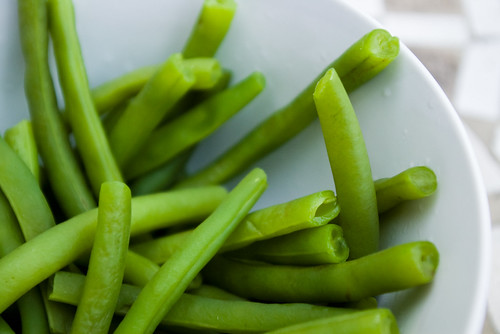
The importance of solid cooking fundamentals can't be overstated. They are the skills that enable a person to toss cook books and recipes and just be in the kitchen. To start, I thought I'd tackle salt, but salt is such a crucial, complex cooking component, I simply can't do it justice in a single blog post. It would probably take an entire book to even scratch the surface of salt's importance, so I decided to stick with green beans.
Salt. It's lifestuff. Our bodies need it to regulate the water that sustains us. Too much salt and we bloat like Ball Park Franks. Too little, and we feel run down, lethargic. Our blood pressure drops, our heart rate increases. We can feel lightheaded or go into shock. It is also fundamental to cooking and is what we talk about when we talk about seasoning.
Properly seasoned food shouldn't taste salty; it should taste like it's supposed to, only more-so. Salt, used properly, will enhance flavors and make them pop. This is perhaps nowhere more evident than with boiled vegetables.
Most people consider boiled vegetables an anathema to good cooking. Boiling, they argue, leeches out the vegetables' essential vitamins and nutrients and leaves nothing but a pale green mush. That may be, for improperly boiled vegetables. Properly boiled, however, will give you delicious, well-seasoned vegetables whose color comes straight out of some MGM musical. The secret is in the ratio:
"For pasta, grains and legumes, enough salt should be added so that the water tastes pleasantly seasoned, between 2 and 3 tablespoons of Morton's kosher salt (or between 1 and 1.5 ounces of any noniodized salt) per gallon; evaluate it just as you would evaluate a soup for proper seasoning level; the salt level of the water will mirror the salt concentration absorbed by the food. For cooking green vegetables, heavily salted water is recommended: between 3/4 and 1 cup Morton's kosher salt (or between 6 and 8 ounces) per gallon of water."
- "Salted Water," Elements of Cooking by Michael Ruhlman
- To begin, select enough green beans for two side servings (I ended with two large handfuls--approximately 50 beans)
- Set 2 quarts of water with six tablespoons of kosher salt added on to boil in a very large pot (4 qt at least)
- Note: People often don't use enough water when boiling vegetables. When the vegetables hit the water, especially if they've come straight from the fridge, they're going to rob the water of its heat. When this happens, the water stops boiling and suddenly your vegetables aren't cooking as quickly or in the manner they should. When boiling vegetables, feel free to use as much water as you can handle. Just remember the ratio: 3/4 cup per gallon.
- While the water comes to a boil, snap the ends off the green beans (like asparagus, they should break where they need to)
- When you're ready, place the green beans into the water and let them boil for about four minutes (as boiling temperatures differ based on proximity to sea level and other factors, your cooking time might be slightly different)
- When the green beans are done, you can toss them with a small dash of very good olive oil, and serve immediately
Note: If you're going to serve the green beans later, you'll want to shock them in an ice water bath to prevent them overcooking. Let them come up to room temperature before you serve them.
Salt is, of course, a subject too complex to handle in a single blog post. In fact, I feel like I'm doing a disservice to the stuff by relegating its use to boiled vegetables, but it's a start. The thing is, you should never be without salt. And not that lame, iodized stuff. It can lend a weird, metallic taste to foods. Get some good kosher salt and learn to season your food. Your food and you family will thank you for it.



No comments:
Post a Comment